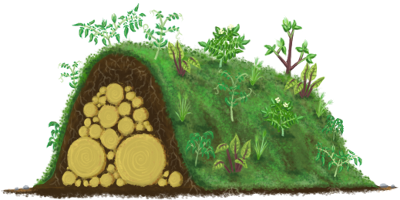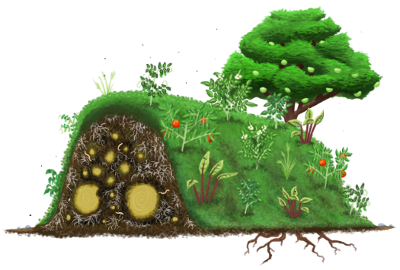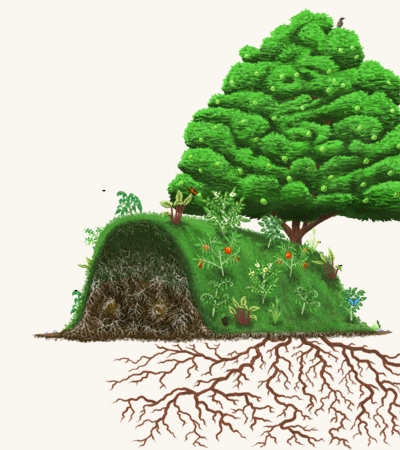by paul wheaton


raised garden bed hugelkultur after one month

raised garden bed hugelkultur after one year

raised garden bed hugelkultur after two years

raised garden bed hugelkultur after twenty years

raised garden bed hugelkultur after one year

raised garden bed hugelkultur after two years

raised garden bed hugelkultur after twenty years
======================
hugelkultur raised garden beds in a nutshell:
It's a german word and some people can say it all german-ish. I'm an american doofus, so I say "hoogle culture". I had to spend some time with google to find the right spelling. Hugal, hoogal, huegal, hugel .... And I really like saying it out loud: "hugelkultur, hoogle culture, hoogal kulture ...." - it could be a chant or something.
I learned this high-falootin word at my permaculture training. I also saw it demonstrated on the Sepp Holzer terraces and raised beds video - he didn't call it hugelkultur, but he was doing it.
Hugelkultur is nothing more than making raised garden beds filled with rotten wood. This makes for raised garden beds loaded with organic material, nutrients, air pockets for the rootsof what you plant, etc. As the years pass, the deep soil of your raised garden bed becomes incredibly rich and loaded with soil life. As the wood shrinks, it makes more tiny air pockets - so your hugelkultur becomes sort of self tilling. The first few years, the composting process will slightly warm your soil giving you a slightly longer growing season. The woody matter helps to keep nutrient excess from passing into the ground water - and then refeeding that to your garden plants later. Plus, by holding SO much water, hugelkultur could be part of a system for growing garden crops in the desert with no irrigation.
I do think there are some considerations to keep in mind. For example, I don't think I would use cedar. Cedar lasts so long because it is loaded with natural pesticides/herbicides/anti-fungal/anti-microbial (remember, good soil has lots of fungal and microbial stuff). Not a good mix for tomatoes or melons, eh? Black locust, black cherry, black walnut? These woods have issues. Black locust won't rot - I think because it is so dense. Black walnut is very toxic to most plants, and cherry is toxic to animals, but it might be okay when it rots - but I wouldn't use it until I had done the research. Known excellent woods are: alders, apple, cottonwood,poplar, willow (dry) and birch. I suspect maples would be really good too, but am not certain. Super rotten wood is better than slightly aged wood. The best woods are even better when they have been cut the same day (this allows you to "seed" the wood with your choice of fungus - shitake mushrooms perhaps?).
Another thing to keep in mind is that wood is high in carbon and will consume nitrogen to do the compost thing. This could lock up the nitrogen and take it away from your growies. But well rotted wood doesn't do this so much. If the wood is far enough along, it may have already taken in sooooo much nitrogen, that it is now putting it out!
Pine and fir will have some levels of tanins in them, but I'm guessing that most of that will be gone when the wood has been dead for a few years.
In the drawings at right, the artist is trying to show that while the wood decomposes and shrinks, the leaves, duff and accumulating organic matter from above will take it's place. The artist is showing the new organic matter as a dark green. Read more, photos, & videos
hugelkultur raised garden beds in a nutshell:
- grow a typical garden without irrigation or fertilization
- has been demonstrated to work in deserts as well as backyards
- use up rotting wood, twigs, branches and even whole trees that would otherwise go to the dump or be burned
- it is pretty much nothing more than buried wood
- can be flush with the ground, although raised garden beds are typically better
- can start small, and be added to later
- can always be small - although bigger is better
- You can save the world from global warming by doing carbon sequestration in your own back yard!
- perfect for places that have had trees blown over by storms
- can help end world hunger
- give a gift to your future self
It's a german word and some people can say it all german-ish. I'm an american doofus, so I say "hoogle culture". I had to spend some time with google to find the right spelling. Hugal, hoogal, huegal, hugel .... And I really like saying it out loud: "hugelkultur, hoogle culture, hoogal kulture ...." - it could be a chant or something.
I learned this high-falootin word at my permaculture training. I also saw it demonstrated on the Sepp Holzer terraces and raised beds video - he didn't call it hugelkultur, but he was doing it.
Hugelkultur is nothing more than making raised garden beds filled with rotten wood. This makes for raised garden beds loaded with organic material, nutrients, air pockets for the rootsof what you plant, etc. As the years pass, the deep soil of your raised garden bed becomes incredibly rich and loaded with soil life. As the wood shrinks, it makes more tiny air pockets - so your hugelkultur becomes sort of self tilling. The first few years, the composting process will slightly warm your soil giving you a slightly longer growing season. The woody matter helps to keep nutrient excess from passing into the ground water - and then refeeding that to your garden plants later. Plus, by holding SO much water, hugelkultur could be part of a system for growing garden crops in the desert with no irrigation.
I do think there are some considerations to keep in mind. For example, I don't think I would use cedar. Cedar lasts so long because it is loaded with natural pesticides/herbicides/anti-fungal/anti-microbial (remember, good soil has lots of fungal and microbial stuff). Not a good mix for tomatoes or melons, eh? Black locust, black cherry, black walnut? These woods have issues. Black locust won't rot - I think because it is so dense. Black walnut is very toxic to most plants, and cherry is toxic to animals, but it might be okay when it rots - but I wouldn't use it until I had done the research. Known excellent woods are: alders, apple, cottonwood,poplar, willow (dry) and birch. I suspect maples would be really good too, but am not certain. Super rotten wood is better than slightly aged wood. The best woods are even better when they have been cut the same day (this allows you to "seed" the wood with your choice of fungus - shitake mushrooms perhaps?).
Another thing to keep in mind is that wood is high in carbon and will consume nitrogen to do the compost thing. This could lock up the nitrogen and take it away from your growies. But well rotted wood doesn't do this so much. If the wood is far enough along, it may have already taken in sooooo much nitrogen, that it is now putting it out!
Pine and fir will have some levels of tanins in them, but I'm guessing that most of that will be gone when the wood has been dead for a few years.
In the drawings at right, the artist is trying to show that while the wood decomposes and shrinks, the leaves, duff and accumulating organic matter from above will take it's place. The artist is showing the new organic matter as a dark green. Read more, photos, & videos
Awesome usable knowledge that can help you feed yourself and others easier and change the world significantly for the better... !!!
Monte & Eileen
Monte & Eileen




No comments:
Post a Comment